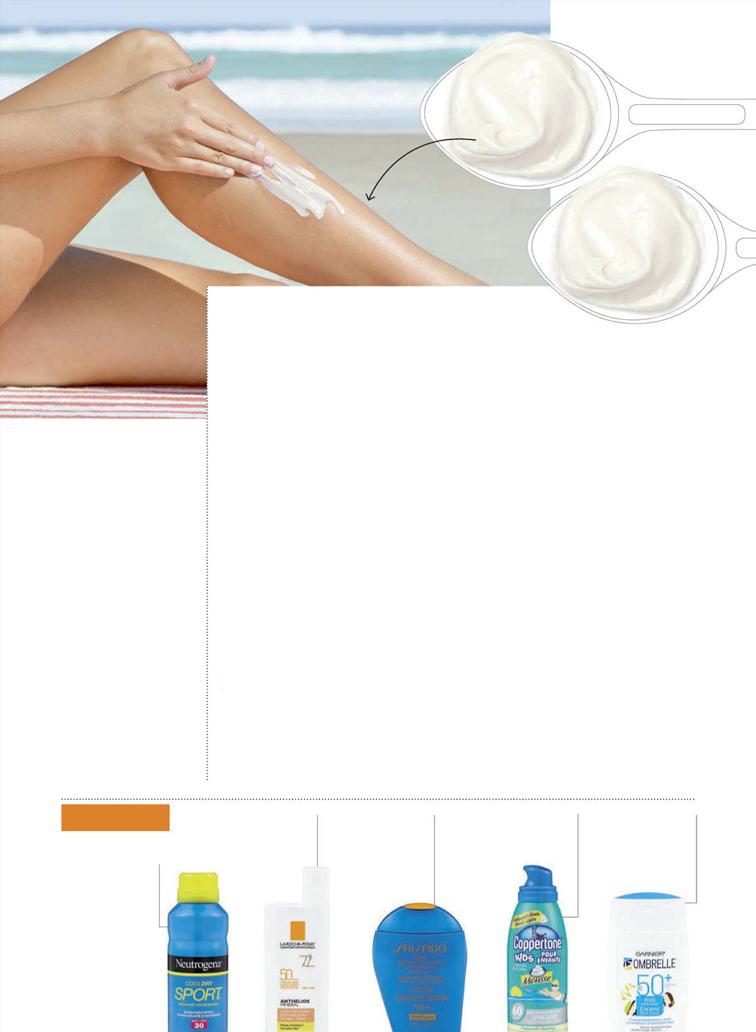
3 minute read
OUTSMART THE SUN
from CL - June 2015
outsmart sunthe
We could all use a sunscreen refresher at this time of year. Keep your skin safe with these best practices.
Advertisement
BY WENDY HAAF QWhen should I put it on? A Apply sunscreen 20 minutes before heading outdoors, even on cloudy days (up to 80 percent of UV rays can penetrate clouds, mist and fog). Be more vigilant about sun safety on days when the UV Index, which measures the strength of the sun’s ultraviolet rays, is 3 or greater, and limit your time in the sun, especially between 10 a.m. and 2 p.m.
QCan I use “body” sunscreen on my face? A Yes, but products formulated for the face may be less likely to clog pores. Look for one that’s labelled “noncomedogenic.” Some moisturizers do double duty as sunscreen—just be sure to choose one with SPF 30 or greater. If you prefer to layer separate products, apply sunscreen first.
QWhere do I apply it? What areas are more prone to skin cancer?
A Sunscreen belongs on any skin that’s not protected by clothing, says Gillian Bromfield, director of cancer control policy for the Canadian Cancer Society. The areas that are likeliest to develop skin cancer are those most often exposed to the sun. The majority of studies point to the upper body (back, shoulders, face and ears) as the most common area for men and women. The Canadian Cancer Society recommends using a lip balm with SPF 15. And don’t forget that sunscreen is only one weapon in the sun-protection arsenal: seek shade and cover up with clothing, sunglasses and a broad-brimmed hat.
Apply two tablespoons
of sunscreen to exposed areas, including your face.

Sunscreen + Insect Repellent
Need to apply both insect repellent and sunscreen? Don’t put them on at the same time, says Xiaochen Gu, professor at the University of Manitoba’s College of Pharmacy. “Suncreens protect the skin from sunlight’s UV radiations and should have direct contact with the skin surface.” The safest strategy, says Gu, is to apply sunscreen first, wait 15 to 30 minutes, then add a layer of repellent. He recommends using a spray repellent; creams require rubbing, which can physically force some of the chemicals into the skin.
QHow much sunscreen do I need?
A An adult should apply two tablespoons of broad-spectrum sunscreen (which offers both UVA and UVB ray protection) with a minimum of SPF 30 onto exposed skin, says Dr. Anatoli Freiman, chair of the Canadian Dermatology Association’s Sun Protection Program and medical director at the Toronto Dermatology Centre. That amount includes up to one teaspoon for the face. Spread sunscreen on skin evenly, then rub the product into your skin until it’s absorbed. If you’re applying the recommended amount every day, the bottle shouldn’t last long—definitely not an entire summer.
QWhat happened to waterproof? A Canadian labelling rules have changed. Sunscreens can no longer claim to be sweatproof or waterproof, only water- and/or sweatresistant for 40 or 80 minutes. Reapply the product after swimming or sweating, or immediately after towel-drying.
QDo children need their own sunscreen? A Typically, children’s sunscreens are formulated for sensitive skin, so they’re less apt to contain common potential irritants and allergens, like fragrance. And remember, sunscreen isn’t recommended for babies under six months of age; the best sun protection is shade and clothing that covers their skin.
QWhat’s the difference between “chemical” and “physical”? A Many people want to minimize their exposure to synthetic chemicals, preferring to rely on UV-filtering ingredients made from natural minerals. Chemical sunscreens with avobenzone (a.k.a. Parsol 1789) and ecamsule (a.k.a. Mexoryl SX) absorb UV rays, while physical agents, such as zinc oxide and titanium dioxide, reflect them. Many products provide both types of protection. Whichever product you choose, the rules are the same: Reapply every two hours.
QWhat about aerosols? A Unfortunately, it’s not yet certain whether the fumes are safe to inhale. Using a spray-on sunscreen also makes it difficult to hit every spot evenly, so it’s best to spray the product directly into your palm, then apply it to your body with your hands.
5 TO TRY
SPRAY-ON
Neutrogena CoolDry Sport Sunscreen Spray SPF 30, $17, shoppersdrugmart.ca.
FOR THE FACE
La Roche-Posay Anthelios 50 Tinted Mineral, $33, shoppersdrugmart.ca.
WATERRESISTANT
Shiseido Ultra Sun Protection Lotion for Face and Body SPF 50+ WetForce, $49, shiseido.ca.
FRAGRANCE-FREE
Coppertone Kids Sunscreen Mousse SPF 60, $12, coppertone.ca.
FOR KIDS
Garnier Ombrelle Kids 100% Mineral Lotion SPF 50+, $20, garnier.ca.










